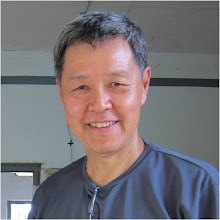 I was thinking about this when I was in Khon Kaen.
I was thinking about this when I was in Khon Kaen.It is not an easy question to resolve, as despite the Thais now being numerically so much larger than the Khmers, the Khmers were so much more dominant historically because of the Angkorean civilization. The earliest recognition of a Thai entity only surfaced when the Angkor civilization started to decline.
In early prehistory the region was populated by a Mon language speaking people. Who were they? Most likely people of a Sino-Tibetan stock. On top of this was a distinct amount of 'indianization' as evidenced by civilizations like the Dvararati (pre-angkorean). What 'indianization' really means is not clear, and it is not certain if this was a cultural thing or there was actually an influx of Indian genes as had happened in Cambodia (through the Kambujas from India). In any case, during the Angkor period, the region was 'Khmer-ized', so I am sure there was a substantial of genetic admixture. (See 'So, who are the Khmers anyway?')
As the Khmer civilization ebbed, the Thai people emerged as a distinct entity through the Lavo and Sukhothai kingdoms. A large part of this may have resulted from an influx of Southern Chinese people from Yunnan, fleeing the Mongol invasions.
Thailand now does not recognize differnt ethnicities within the country and everyone is regarded as Thai, although unofficially different ethnic groups are apparent. In a very broad sense, indigenous Thais are generally a sino-tibetan people with a variable amount of Indian admixture. There may be some degree of contribution from the austronesian gene pool, especially in Southern Thailand. On top of these are more recent contributions from Southern China.
So how do we regard pharmacogenetic data from Thailand? I think it becomes important for us to evaluate the source of the data. If it is generated in large urban centres, the contribution of Chinese genes is quite substantial. Indigenous Thai data is best seen in studies conducted in rural communities. In Southern Thailand, one must expect a significant amount of similarity to 'Malay' genetics. In the southern provinces, there still remain pockets of negrito peoples.
This is so far my limited understanding of the situation. I may be wrong. But this is how the current understanding appear to leading us. Perhaps there may be others with a better understanding of Thai ethnicity who can share their experiences and understanding with us?








No comments:
Post a Comment